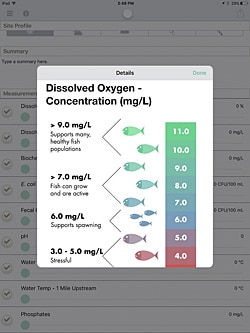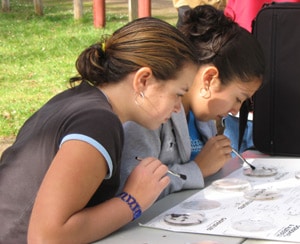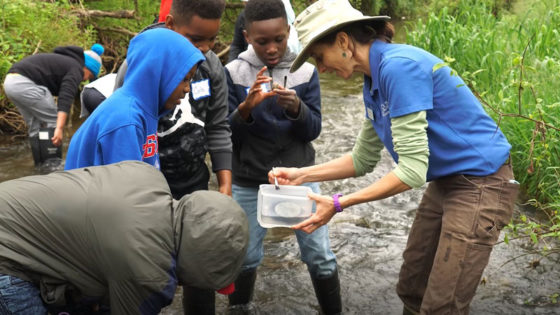A version of this article, authored by R. Justin Hougham and Steve Kerlin, first appeared in the Fall 2016 issue of Green Teacher.
Today’s educators are interested in using technology to enhance or expand the outdoor education experience. But too often, the adoption of technologies hinges on the newness of a device or app. For better success, it’s important to consider factors such as cost, age-group appropriateness, and training requirements before use.
Whether you are a teacher, parent, or citizen scientist, here are a few ideas worth considering to make the most of mobile digital technology for environmental education.
#1: Choose Technologies That Connect Learners With Their Surroundings
Researchers have found that for mobile technology to successfully connect learners with their surroundings, it should feature
- scalable scientific inquiry,
- student-generated knowledge,
- focused local observations, and
- a team-member approach.
One example of a mobile technology that connects students to the outdoors in new and exciting ways is the Digital Observation Technology Skills (DOTS) kit paired with the Digging Deeper With Data (DDD) program, both from University of Wisconsin-Extension.
The DOTS kit contains many tools, including wireless microscopes, thermal imagers, GPS devices, and handheld weather stations. Educators can pair it with the DDD program so that students use the contents of the DOTS kit to support daily atmospheric and terrestrial observations around the schoolyard. Students use infrared imagers, digital microscopes, weather stations, and cameras to build a complete description of their environment.
The inquiry-based curriculum navigates the basics of the scientific method and focuses on the importance of good scientific communication and sharing discoveries with others.
#2: Do Your Research Before Downloading
The Field Friendly Apps website shares reviews and recommendations of apps that are appropriate for outdoor education along with tips, tricks, and other helpful information.
One common misconception by new users is that mobile apps, and the smartphones and tablets that run them, require continual cellular or Wi-Fi service. This is not the case for most apps. Users download the app to their device ahead of time, use the app in the field (e.g., for data collection or identification), and if desired upload or export data once they return to cellular or Wi-Fi service.
Many apps are free, but you may find that the paid pro versions have more educational resources and fewer distractions such as advertisements. Most paid education apps are $10 or less.

The Water Quality Mobile App is one example of a mobile app that was specifically developed for education and citizen science purposes to enhance and extend learning in stream study activities and stream monitoring.This app functions as a digital lab report — stream data (including physical, chemical, and biological parameters) can be stored and exported for further study. It also features learning pop-ups that help students and citizen scientists understand the stream-quality data they’ve collected, such as
- what levels of dissolved oxygen are needed for aquatic species to survive,
- which organisms can live at different pH levels,
- how the distribution of common macroinvertebrates found in the stream are used to assess stream health, and more.
Another app worth a look is the Corinth Micro Plant app ($2.99) available on Microsoft Surface devices. This app digs into the details of the anatomy of a tree, intuitively scaling from the tree-level view down to the cellular level. This has tested well with youth in outdoor education, compared with the traditional outdoor education approach.
#3: Consider How You Want to Use Your Data
Education apps such as the Water Quality app can export field data from the mobile device to simple Excel (csv) files, PDFs, or pictures, or data can be uploaded to databases. Then teachers can guide students through comparing and graphing data across student groups, between field study sites, or over time, which allows teachers to extend student learning beyond a one-day field trip.
Many field-based education apps also allow students and teachers to contribute to citizen science.

The Leaf Pack Network® (LPN), coordinated by Stroud Water Research Center, is an example of a web app that collects citizen science data. The LPN database currently includes water-quality data from 455 registered user groups from 11 countries, 671 completed experiments, and 97,074 macroinvertebrates identified.To collect the water-quality data, participants create a pack of local leaves and place it in a stream for three to four weeks. When they remove the leaf packs from the stream they use LPN protocols to identify the macroinvertebrates living in the leaf packs.
Students, teachers, and citizen science groups then submit their data to the Leaf Pack Network database, which returns a water quality score. The data is then available on the LPN website for anyone to access and study.
Technology has much to offer environmental educators, and it is also an ever changing horizon of what will work in outdoor contexts, be relevant, and enhance learning experiences. Time invested in reviewing and selecting technology and apps before making purchases is time well spent.
Top 4 Ways to Use Technology to Engage Environmental Education Students
- Partner organizations that want to use technology with those that are already having successes.
- Provide hands-on workshops to train instructors in using mobile digital technologies.
- Conduct your own research in this emerging area of environmental education.
- Use an approach rooted in place-based education to collect data.



